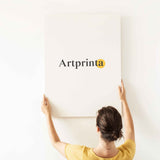Lorenzo Lotto, 1533 - Madonna and Child with Two Donors - fine art print
Taxes incluses. Frais de port calculés au paiement.
Product explanation
This painting was painted by the male painter Lorenzo Lotto. This work of art is in the the The J. Paul Getty Museum's digital art collection. With courtesy of - The J. Paul Getty Museum (licensed - public domain).Furthermore, the work of art has the creditline: . The alignment is landscape with a ratio of 4 : 3, which implies that the length is 33% longer than the width. Lorenzo Lotto was a male painter from Italy, whose art style can mainly be classified as High Renaissance. The Italian artist lived for 81 years, born in 1475 in Venice, Venezia province, Veneto, Italy and deceased in the year 1556 in Loreto, Ancona province, Marches, Italy.
Product materials you can pick from
We offer a range of different materials and sizes for every product. The following options are available for individualization:
- Canvas print: A canvas direct print is a printed canvas mounted on a wood stretcher. Also, a canvas print makes a attractive and pleasing impression. A canvas print has the advantage of being relatively low in weight. That means, it is easy and straightforward to hang your Canvas print without the use of additional wall-mounts. Therefore, canvas prints are suited for all kinds of walls.
- Poster print (canvas material): The Artprinta poster is a printed canvas with a slightly roughened surface texture. It is designed for framing the art copy with the help of a custom-made frame. Please note, that depending on the size of the poster we add a white margin of something between 2-6cm round about the painting in order to facilitate the framing with your custom frame.
- Aluminium dibond print (metal): Aluminium Dibond prints are prints on metal with a true effect of depth. A direct Direct Print on Aluminum Dibond is your ideal start to the sophisticated world of reproductions with aluminum.
- Printed acrylic glass: A glossy acrylic glass print, which is often described as a plexiglass print, changes your selected original work of art into wonderful wall décor. In addition, it makes a distinct alternative to dibond and canvas fine art prints. Your own version of the work of art will be printed with the help of modern UV direct print machines. This has the impression of sharp and vivid colors. Our real glass coating protects your custom art replica against light and external influences for between 4 and six decades.
Disclaimer: We do whatever we can in order to describe the products as exact as possible and to showcase them visually. Please bear in mind that some pigments of the printing material and the print result might vary somehwat from the image on the device's screen. Depending on your settings of your screen and the condition of the surface, not all colors can be printed 100% realistically. Considering that the fine art prints are processed and printed manually, there may as well be minor deviations in the motif's exact position and the size.
Structured article details
| Product categorization: | art print |
| Reproduction: | digital reproduction |
| Production method: | UV direct printing |
| Production: | manufactured in Germany |
| Stock type: | production on demand |
| Product use: | wall decoration, art reproduction gallery |
| Alignment of the artwork: | landscape format |
| Image ratio: | 4 : 3 - length : width |
| Implication of side aspect ratio: | the length is 33% longer than the width |
| Available material options: | metal print (aluminium dibond), canvas print, acrylic glass print (with real glass coating), poster print (canvas paper) |
| Canvas print (canvas on stretcher frame) sizes: | 40x30cm - 16x12", 80x60cm - 31x24", 120x90cm - 47x35", 160x120cm - 63x47" |
| Acrylic glass print (with real glass coating) sizes: | 40x30cm - 16x12", 80x60cm - 31x24", 120x90cm - 47x35", 160x120cm - 63x47" |
| Poster print (canvas paper) options: | 40x30cm - 16x12", 80x60cm - 31x24", 120x90cm - 47x35" |
| Aluminium print sizes: | 40x30cm - 16x12", 80x60cm - 31x24", 120x90cm - 47x35" |
| Art print framing: | not available |
Structured information on the piece of art
| Work of art title: | "Madonna and Child with Two Donors" |
| Categorization: | painting |
| Umbrella term: | classic art |
| Period: | 16th century |
| Created in the year: | 1533 |
| Approximate age of artwork: | around 480 years |
| Museum / collection: | The J. Paul Getty Museum |
| Museum location: | Los Angeles, California, United States of America |
| Web page: | www.getty.edu |
| Artwork license type: | public domain |
| Courtesy of: | The J. Paul Getty Museum |
Background information on the artist
| Artist: | Lorenzo Lotto |
| Alternative names: | Laurenso Lotto, Laurent Lotto, L. Lotto, Lorenzo Lot Diszipulo de Corezo, Laurentius Lottus, Lorenzo Lot, Lorenzo Lotto, Lotto Lorenzo, Lazzaro Lotti, Lotto Laurentio, Lorenzo Lotto da Bergamo, Loti, Lotto, lorenzo loto, Lorenzo Lotti, L. Lotti, Lotto Lorenzo, Laurentius Lotus |
| Gender of the artist: | male |
| Nationality of artist: | Italian |
| Jobs: | painter |
| Country of the artist: | Italy |
| Artist category: | old master |
| Art styles: | High Renaissance |
| Died aged: | 81 years |
| Year of birth: | 1475 |
| Born in (place): | Venice, Venezia province, Veneto, Italy |
| Died in the year: | 1556 |
| City of death: | Loreto, Ancona province, Marches, Italy |
This text is intellectual property and protected by copyright ©, Artprinta.com (Artprinta)
(© Copyright - by The J. Paul Getty Museum - The J. Paul Getty Museum)
Framed by richly draped fabric, the Virgin Mary tenderly sits Christ on her lap. The couple who commissioned the panel look up at the child, meeting his eyes as he rewards their piety with a blessing. As the symbol of Christ's resurrection, the fig branch growing behind the curtain also reassures the donors of their own redemption.
In the late 1400s, well-to-do families often commissioned such pictures for hanging in the home or the private chapel of a church. These panels served both as portraits and as testimonies to the donors' religious devotion.
Lorenzo Lotto emphasized the contrast between the earthly and the spiritual realms by using a highly naturalistic style for the couple and a more ideal, poetic rendering for the Virgin and child. With a flair for color betraying his Venetian origins, Lotto contrasted Mary's luminous blues and reds with the donors' more somber clothing.














